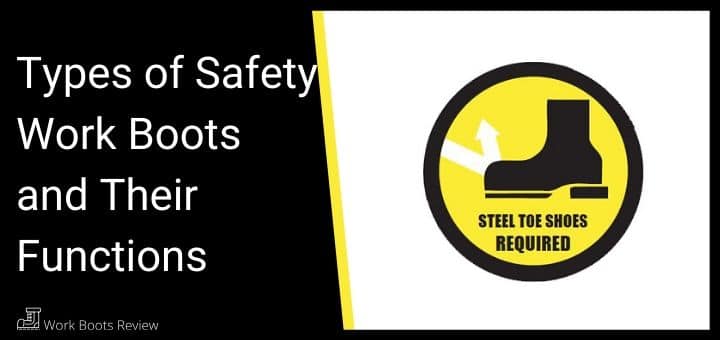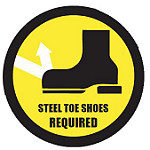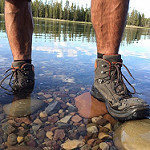
Having the right tools for the job goes without saying, the same goes for wearing the right safety footwear for your job and work environment.
The main purpose of your safety work boot is to be durable, reliable and provide you with protection against work hazards.
How to Choose the Right Safety Work Boot
Choosing the right work boot boils down directly to what your job description is and the environment that you are working in.In most cases, industrial companies require that you wear a safety work boot that is ASTM F2413 rated, which provides protection against falling objects, electrical hazards, and punctures.
I have made a list of the most common potential hazards that you get in most work environments, for which a safety work boot is required;
- ELECTRICAL HAZARDS – A work boot manufactured from a non-conductive material, with shock resistant soles and heels will prevent electrocution.
EXPLOSIVES – In the case where you work around explosives or flammable materials, a shoe that dissipates static electricity, which can cause a spark, is necessary. Heat protection in this regard can also be a plus point when you are dealing with hot metals and liquids.
CHAINSAWS – For occupations such as logging where there is frequent use of saws and chainsaws, or even an occupation where you are around machinery with sharp moving parts, cut-resistant boots are a must. These work boots are manufactured from materials that offer protection and resistance against spinning blades.
FALLING OBJECTS – In most work environments there is a risk of falling objects. A work boot with a toe cap can protect your toes and feet against heavy falling objects. The toe cap usually consists of either steel, aluminum or a composite material.
SHARP OBJECTS – Sharp objects on any work floor can pose a risk, especially if you wear shoes with a thin penetrable outsole. A puncture-resistant work boot has a steel or composite plate inside the midsole, positioned in such a manner as to protect the feet against puncture wounds.
COMPRESSION HAZARDS – Rolling machinery and objects can cause what we call a compression hazard, that can damage the top part of your feet. A metatarsal guard ensures
COLD AND HEAT – Some work boots have the additional safety feature of insulation, to protect you against moreover extreme cold conditions, or on the contrary, extreme heat conditions.
WATERPROOF – When working in conditions that are wet, you may want to opt for a work boot that is water resistant. Keeping your feet dry in turn safeguards you against cold, foot fungus and discomfort.
SLIP RESISTANCE – Anything from loose stones, to oil and wetness can cause a slipping hazard. Wearing work boots that offer good traction and resistance to slip hazards, will prevent slips and falls.
 MOLTEN METAL – Some safety work boots offer insulated shielding against hot molten metals, and similarly have an easy slip of the design in case of a serious burn.
MOLTEN METAL – Some safety work boots offer insulated shielding against hot molten metals, and similarly have an easy slip of the design in case of a serious burn.
Safety Shoe Types for Different Work Environments
There are a few different types of safety shoes available for different work circumstances. Take into consideration that most Safety Work Boots have slip-resistant soles, among other safety features that come standard.Safety Toe

The main specification in any Safety work Boot is a safety toe, which like said before can be either steel, aluminum or a composite toe.
Steel Insole
Many work boots types have steel, or hard plastic, or fiberglass insole to prevent puncture injuries.
Metal Instep
Similar to a steel insole, the metal instep also protects your feet from outward injuries.
This type of shoe is designed specifically for this purpose, to guard your feet against puncture wounds from nails, glass and other sharp metal objects that may be present on the floors of your work area.
Metatarsal Protection
Almost like the safety toe cap a metatarsal guard protects the top part of the foot from falling objects and not only the toes. you can purchase a work boot with a metatarsal guard, or purchase a separate metatarsal protective flap for your work boot.
Electrical Hazard Safe
These are safety work boots that protect you against electrical hazards such as non-conductive shoes with a leather or rubber sole to prevent electrocution.
Similarly, you also get work boots that prevent the assimilation of static electricity which can cause a spark, which in turn poses a great risk in an environment with flammable materials.
Insulated Work Boots
For working in extremely cold weather or work conditions you can opt for an insulated work boot with an insulation rating, to suit the degrees of the weather.
On the other hand, you can do the same in very hot weather or work environment conditions. Insulated work boots for heat protection are available to keep your feet cool in hot conditions.
Then again you also have the option of lightweight breathable work boots made from fabrics that can breathe and have the ability to dry fast.
Waterproof

Lastly, many individuals work in either wet environments or wet weather conditions, in this instance, a waterproof work boot is much desired. Nobody likes cold wet feet, not to mention the disease and discomfort that it can cause, therefore, ample waterproofing in your work boot can make a huge difference.
Most work boots are waterproof, but if you do work in wet conditions at times, make sure that you have that feature available to you.
To Conclude
What I would like to communicate with this article is the fact that most of us look for a more comfortable and affordable way out when it comes to work boots.
Yes, comfort and support are important, but so is your safety and that of those around you. The proper safety work boot for your work environment is just as important as rest of your protective gear.
So rather than fixating on the price, regarding your safety, and the longevity of your work boots first, along with a comfortable fit, you will perform at your best and remain safe at work.
